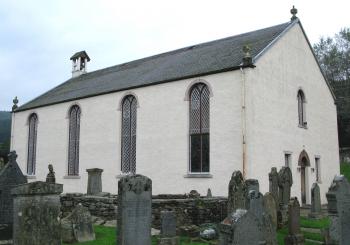- Navigation:
- Back to the Corpus index page
- RSS
Logierait / Logie-Mahedd / Laggan Mochaid Parish Church
Logierait Church, exterior, from south
- Dedication: St Mochaid?
- Diocese of Dunkeld
- Deanery of Athole and Drumalbane
- County of Perthshire
- Perth and Kinross Council
- NN 9679 5201
Summary description
There is no trace of the medieval parish church, the site of which is likely to be occupied by the existing building of 1804-6.
Historical outline
Dedication: St Mochaid?
The presence of Class II and Class III Pictish sculpture at the church in Logierait, coupled with the existence of no less than four dependent chapels within the parish before the end of the twelfth century, suggest that this was an early ecclesiastical centre of some considerable importance. There is, however, no surviving documentary evidence for its status until the church of Laggan Mochaid with its chapels was granted to the canons of Scone by Earl Malcolm of Atholl. The earl’s charter has not survived but the confirmation of his grant by King William has.(1) The king’s charter names the dependent chapels as Killiechangie, Dunfallandy, Killiechassie (later falling within Weem parish) and Kilmichael of Tulliemet. Bishop John confirmed possession of the church in proprios usus to the canons of Scone before 1214, his charter providing the observation that the church lay adjacent to the caput of the earls of Atholl at ‘Rath’, the residence which is represented by the –rait element in the modern name of Logierait.(2) The annexation was clearly successful as the church is not listed in Bagimond’s Roll. Possession was confirmed by successive bishops of Dunkeld, with Bishop Geoffrey (1236-49) also giving the canons the right to serve the cure either with a secular chaplain or one of their own number.(3) The church remained annexed to Scone at the Reformation, when it was served by a vicar pensionary.(4)
Notes
Architectural analysis
One of the two Early Christian cross slabs to have been found in the churchyard at Logierait is still in the churchyard to the south of the church. It has a cross on one side and a mounted figure and serpent symbol on the other. The other, which is now laid out in the church, has a cross on one side and Pictish symbols on the other. It would be good to know if it was one of those cross slabs that was referred to in 1793, when it was said in the Statistical Account that ‘a broken cross upon the church indicates it to have been built in times when Popery was the established religion of the kingdom’.
There is presumably no reason to doubt that the churchyard was the site of the medieval parish church, and certainly there are a number of memorials that pre-date by several decades the existing church, which was built to the designs of John Stewart in 1804-6. Nothing is known to have survived of the medieval parish church, however.
Bibliography
Allen, J.R. and Anderson, J., 1903, The Early Christian Monuments of Scotland, Edinburgh, pt 3, 291-2.
Cowan, I.B., 1967, The parishes of medieval Scotland, (Scottish Record Society), Edinburgh, 138.
Gifford, J., 2007, The Buildings of Scotland, Perth and Kinross, New Haven and London, 506-7.
Hay, G., 1957, The architecture of Scottish post-Reformation churches, Oxford, 269.
Kirk, J., 1995, The books of assumption of the thirds of benefices, (British Academy) Oxford, 332, 333, 338.
Liber ecclesie de Scon, 1843, (Bannatyne Club) Edinburgh, nos 27, 55, 100.
Mackinlay, J.M., 1914, Ancient church dedications in Scotland, non-scriptural dedications, Edinburgh, 240, 260.
New Statistical Account of Scotland, 1845, Edinburgh and London, x, 698.
Registrum Secreti Sigilli Regum Scotorum, 1908-82, ed. J.M. Thomson et al., Edinburgh, ii, no 360.
Royal Commission on the Ancient and Historical Monuments of Scotland, Canmore database.
Statistical Account of Scotland, 1791-9, ed. J. Sinclair, Edinburgh, v (1793), 80.
Map
Images
Click on any thumbnail to open the image gallery and slideshow.










